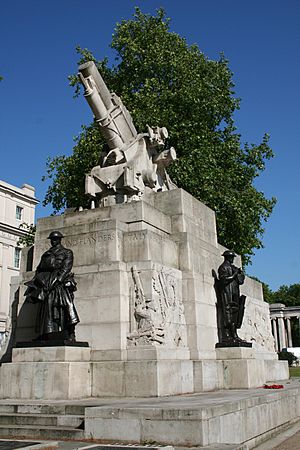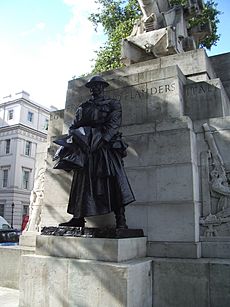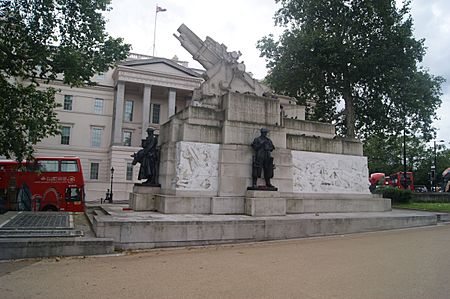Royal Artillery Memorial facts for kids
Quick facts for kids Royal Artillery Memorial |
|
|---|---|
| United Kingdom | |
 |
|
| For casualties of the Royal Regiment of Artillery in the First World War |
|
| Unveiled | 18 October 1925 |
| Location | 51°30′09″N 0°09′07″W / 51.5025°N 0.151944°W Hyde Park Corner, London, SW1
|
| Designed by | Charles Sargeant Jagger, Lionel Pearson |
|
In proud remembrance of the forty-nine thousand & seventy-six of all ranks of the Royal Regiment of Artillery who gave their lives for king and country in the Great War 1914–1919
|
|
|
Listed Building – Grade I
|
|
| Official name | Royal Artillery Memorial |
| Designated | 14 January 1970 |
| Reference no. | 1231613 |
The Royal Artillery Memorial is a special monument in London, England. It stands at Hyde Park Corner. This memorial was built to remember the 49,076 soldiers from the Royal Artillery who died in the First World War.
The memorial was designed by Charles Sargeant Jagger. He was a soldier himself and was hurt in the war. Lionel Pearson helped with the building's design. The monument was officially shown to the public in 1925. It is different from many other war memorials because it shows real scenes from the war. It even includes a statue of a dead soldier.
Contents
Remembering World War I Soldiers
The First World War happened from 1914 to 1918. During this war, artillery (large guns) was used a lot. More than half of all injuries and deaths in the war were caused by artillery. This was especially true on the Western Front. Artillery guns and their crews were often targets. Sadly, 49,076 Royal Artillery soldiers died.
After the war, many people found it hard to deal with the huge number of deaths. They often avoided things that reminded them of the fighting. Most war memorials at the time showed peaceful or heroic figures. They did not usually show injured or dead soldiers.
Why This Memorial Is Different
A group called the Royal Artillery War Commemoration Fund (RAWCF) was started in 1918. They wanted to create a special memorial for the fallen artillerymen. Earlier war memorials, like those for the Second Boer War, were often criticized. People thought they were not very creative. The RAWCF wanted their memorial to be much better.
They looked for a design that would clearly show it was for artillery. They wanted it to be "unmistakably recognisable" as an artillery monument. This meant it needed to show real artillery equipment.
Creating the Memorial
The RAWCF first asked famous architects like Edwin Lutyens to design the memorial. But these architects' designs did not show artillery clearly enough. The RAWCF wanted a large gun to be a main part of the monument. Because of this, the architects eventually stopped working on the project.
Charles Sargeant Jagger's Design
In 1921, the committee asked Charles Sargeant Jagger to create the memorial. Jagger had been a soldier in the First World War. He was known for making very realistic sculptures for war memorials. His designs were often different from others. They showed the harsh reality of war.
Jagger worked with architect Lionel Pearson on the stone parts. Jagger strongly believed the memorial should focus on the war itself. He said it "should in every sense be a war memorial." He chose a howitzer (a type of artillery gun) to represent the power of artillery.

Jagger's first design had two soldiers and a smaller howitzer. He later changed it to be bigger and shaped like a cross. He also added three bronze soldiers. The howitzer was turned to face south, towards the Wellington Arch. This made it look better from the park.
Adding the Dead Soldier
In 1924, Jagger made another important change. He added a statue of a dead soldier to one side of the memorial. This was very unusual for war memorials at that time. Most memorials showed death in a more abstract or symbolic way. Jagger felt strongly that this figure was important. He even offered to pay for it himself. After much discussion, the RAWCF agreed to include it.
The models for some of the statues were real people. William Fosten was the model for the driver. Another ex-gunner named Metcalfe was the ammunition carrier. Lieutenant Eugene Paul Bennett, who fought in the same regiment as Jagger, modeled for the commander.
What the Memorial Looks Like
The Royal Artillery Memorial is very large. It is 43 feet long, 21 feet wide, and 30 feet high. It is made of Portland stone. On top, there is a large replica of a BL 9.2-inch howitzer gun. This gun is based on a real one at the Imperial War Museum.
The Bronze Figures
At the ends of the cross-shaped base, there are four bronze statues:
- An artillery captain holding a greatcoat (facing south).
- A shell carrier (on the east side).
- A driver wearing a heavy cape (on the west side).
- A dead soldier (on the north side), covered by his greatcoat with his helmet on his chest.
Carved Scenes and Inscriptions
The sides of the memorial have detailed relief sculptures. These show different scenes from the First World War. You can see heavy artillery in action and howitzer crews. There are also scenes with horse artillery and signalmen.
The main message on the memorial reads: "In proud remembrance of the forty-nine thousand and seventy-six of all ranks of the Royal Regiment of Artillery who gave their lives for King and country in the Great War 1914—1919". Below the dead soldier, it says: "Here was a royal fellowship of death." This quote is from William Shakespeare's play Henry V.
Meaning and Impact
The Royal Artillery Memorial is very different from other war monuments. It uses a realist style. This means it shows things as they really are, without using classical symbols. The figures look tired or thoughtful, not always heroic. The dead soldier is shown at eye level, which was very unusual and powerful.
Jagger said his experiences in the trenches taught him to be "frank and truth" in his art. The memorial shows the strength and power of the artillery. It also shows the hard work and sacrifice of the soldiers. It helps people understand the real experience of war.
Later Years and Protection
The memorial was officially shown on 18 October 1925 by Prince Arthur. Even though it was controversial at first, it became very popular. Many ex-servicemen liked its realistic style. It is now seen as one of Britain's best war memorials.
In 1949, bronze plaques were added to the memorial. These remember the 29,924 Royal Artillerymen who died in the Second World War. These were unveiled by Princess Elizabeth, who later became Queen Elizabeth II.
Over the years, the memorial was damaged by weather and water. In 2011, English Heritage did a big restoration project. They cleaned and repaired the bronzes and stonework.
The Royal Artillery Memorial is a Grade I listed building. This means it is a very important historical structure and is protected by law. It is one of the most important monuments in London.
Images for kids






